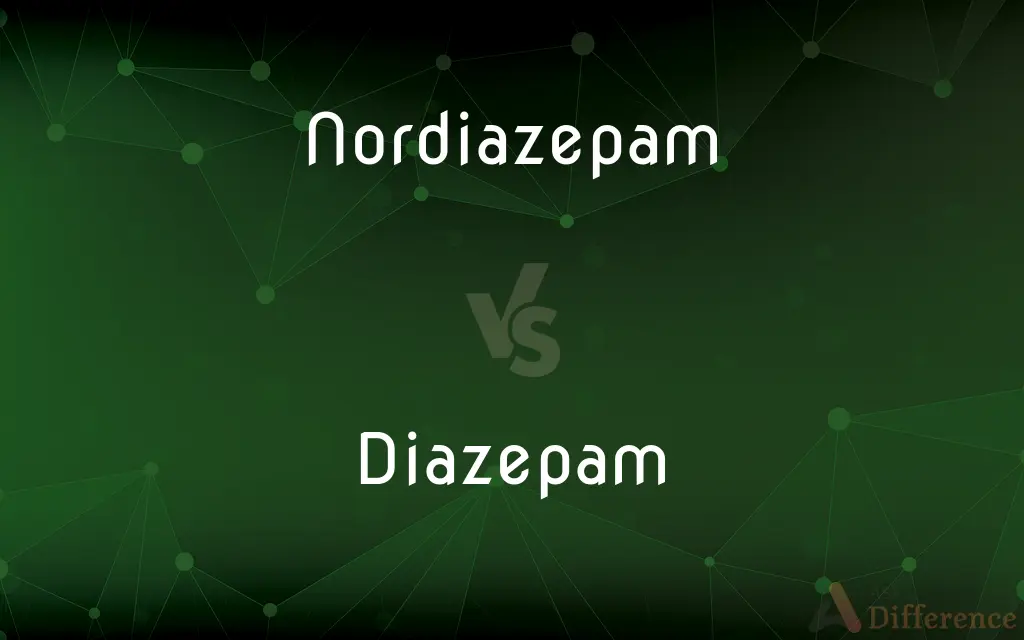Nordiazepam vs. Diazepam — What's the Difference?
By Tayyaba Rehman & Fiza Rafique — Updated on April 8, 2024
Nordiazepam is a metabolite of diazepam, known for its longer half-life and gradual onset, while diazepam acts quickly and is used for acute anxiety relief and muscle relaxation.

Difference Between Nordiazepam and Diazepam
Table of Contents
ADVERTISEMENT
Key Differences
Nordiazepam, as a metabolite of diazepam, inherits many of its parent compound's pharmacological effects but distinguishes itself with a longer duration of action. This makes it potentially more suitable for conditions requiring sustained anxiolytic effects. On the other hand, diazepam is preferred for immediate relief due to its rapid onset of action, making it ideal for acute anxiety attacks or pre-procedural sedation.
Nordiazepam's slower metabolism contributes to its extended half-life, which can be advantageous in maintaining steady therapeutic levels over time. Whereas, diazepam's faster metabolism allows for more control over dosing intervals and a reduced risk of accumulation in the body, which is beneficial in short-term treatment scenarios.
The pharmacokinetic profile of Nordiazepam leads to a reduced peak plasma concentration, resulting in fewer peak-dose side effects compared to diazepam. This characteristic minimizes the risks of over-sedation and cognitive impairment in the short term. Diazepam, however, due to its higher peak concentrations, may offer more immediate symptom relief but with an increased likelihood of side effects such as drowsiness and impaired motor skills.
In terms of therapeutic application, Nordiazepam is not commonly prescribed as a primary medication but is recognized for its role in the metabolism of diazepam and certain other benzodiazepines. This indirect usage underscores its importance in long-term pharmacotherapy. Diazepam, conversely, is widely used and directly prescribed for a variety of conditions, from acute anxiety and seizure disorders to muscle spasms, illustrating its versatility and immediate therapeutic benefits.
The safety profile of Nordiazepam shows it to be generally well-tolerated, with adverse effects similar to but less intense than those of diazepam, due to its more gradual pharmacological impact. Diazepam, while also safe when used as directed, requires careful monitoring for signs of dependency, withdrawal, and other more pronounced side effects, especially with long-term use.
ADVERTISEMENT
Comparison Chart
Onset of Action
Gradual
Rapid
Half-Life
Longer (up to 100 hours in some cases)
Shorter (approximately 20 to 50 hours)
Primary Use
Metabolite in the metabolism of benzodiazepines
Acute anxiety relief, muscle relaxation, seizures
Peak Plasma Concentration
Lower, resulting in fewer peak-dose side effects
Higher, leading to immediate relief but higher risk of side effects
Pharmacological Effects
Sustained anxiolytic and sedative effects
Immediate anxiolytic, sedative, and muscle relaxant effects
Compare with Definitions
Nordiazepam
A benzodiazepine metabolite with a long half-life, providing prolonged effects.
Nordiazepam's extended effect is beneficial for patients needing constant anxiety management.
Diazepam
It has a moderate half-life, balancing duration of effect with medication flexibility.
Diazepam offers relief from symptoms while allowing for adjustable dosing schedules.
Nordiazepam
Has a lower risk of peak-dose side effects compared to its parent drug.
Patients may experience fewer issues with over-sedation when their treatment indirectly involves nordiazepam.
Diazepam
Directly affects the central nervous system to produce its therapeutic effects.
Diazepam's calming effect is due to its direct action on GABA receptors in the brain.
Nordiazepam
Not typically prescribed directly, it is a significant metabolite of diazepam and other benzodiazepines.
Upon metabolizing diazepam, the body produces nordiazepam, contributing to sustained therapeutic levels.
Diazepam
A fast-acting benzodiazepine used for anxiety, muscle spasms, and seizures.
Diazepam quickly alleviates acute anxiety episodes, making it a go-to in emergencies.
Nordiazepam
Known for its gradual onset of action.
Nordiazepam's effects emerge more slowly than its parent compound, avoiding sudden sedation.
Diazepam
Known for its rapid onset, it's often used for immediate relief.
In situations requiring quick intervention, diazepam's fast action is critical.
Nordiazepam
Useful in long-term benzodiazepine pharmacotherapy due to its steady state.
Nordiazepam's presence in the bloodstream helps maintain a consistent therapeutic effect over time.
Diazepam
Can lead to dependence and withdrawal symptoms with long-term use.
Patients are advised to use diazepam cautiously due to potential dependency.
Nordiazepam
The drug nordazepam.
Diazepam
Diazepam, first marketed as Valium, is a medicine of the benzodiazepine family that acts as an anxiolytic. It is commonly used to treat a range of conditions, including anxiety, seizures, alcohol withdrawal syndrome, benzodiazepine withdrawal syndrome, muscle spasms, insomnia, and restless legs syndrome.
Diazepam
A benzodiazepine drug, C16H13ClN2O, used to treat anxiety and alcohol withdrawal and as a sedative, skeletal muscle relaxant, and anticonvulsant.
Diazepam
(pharmaceutical drug) A tranquilizing muscle relaxant drug (trademark Valium) used chiefly to relieve anxiety.
Diazepam
A tranquilizer (trade name Valium) used to relieve anxiety and relax muscles; acts by enhancing the inhibitory actions of the neurotransmitter GABA; can also be used as an anticonvulsant drug in cases of nerve agent poisoning
Common Curiosities
What is Nordiazepam?
Nordiazepam is a metabolite of diazepam and other benzodiazepines, known for its long half-life and gradual effects.
What is Diazepam used for?
Diazepam is used to treat anxiety, muscle spasms, and seizures, offering rapid symptom relief.
How do Nordiazepam and Diazepam differ in their onset of action?
Nordiazepam has a gradual onset, while diazepam acts quickly.
Is Diazepam effective for acute anxiety relief?
Yes, Diazepam is effective for immediate relief from acute anxiety.
What are the risks of Diazepam?
Diazepam can lead to dependence, withdrawal symptoms, and other side effects with long-term use.
Which has a longer half-life, Nordiazepam or Diazepam?
Nordiazepam has a longer half-life compared to Diazepam.
How does Nordiazepam affect the body compared to Diazepam?
Nordiazepam has a more gradual impact with sustained effects, whereas Diazepam provides immediate therapeutic benefits.
Can Nordiazepam be used as a primary medication?
Nordiazepam is not typically prescribed as a primary medication; it's a metabolite of diazepam.
What are the therapeutic uses of Nordiazepam?
Nordiazepam is used indirectly through the metabolism of diazepam, aiding in long-term anxiolytic and sedative effects.
Can Diazepam cause over-sedation?
Yes, due to its rapid onset and higher peak plasma concentration, Diazepam can cause over-sedation.
Why might a doctor prescribe Diazepam over other benzodiazepines?
A doctor might prescribe Diazepam for its rapid onset of action and versatility in treating various conditions.
What is the primary advantage of Diazepam's pharmacokinetics?
The primary advantage is its flexibility in dosing and immediate relief from symptoms.
How is Diazepam metabolized in the body?
Diazepam is metabolized in the liver to produce several metabolites, including Nordiazepam.
Does Nordiazepam have fewer side effects than Diazepam?
Yes, Nordiazepam generally has fewer and less intense side effects due to its gradual pharmacological action.
Share Your Discovery

Previous Comparison
Contact vs. Talk
Next Comparison
Fitter vs. NitterAuthor Spotlight
Written by
Tayyaba RehmanTayyaba Rehman is a distinguished writer, currently serving as a primary contributor to askdifference.com. As a researcher in semantics and etymology, Tayyaba's passion for the complexity of languages and their distinctions has found a perfect home on the platform. Tayyaba delves into the intricacies of language, distinguishing between commonly confused words and phrases, thereby providing clarity for readers worldwide.
Co-written by
Fiza RafiqueFiza Rafique is a skilled content writer at AskDifference.com, where she meticulously refines and enhances written pieces. Drawing from her vast editorial expertise, Fiza ensures clarity, accuracy, and precision in every article. Passionate about language, she continually seeks to elevate the quality of content for readers worldwide.














































